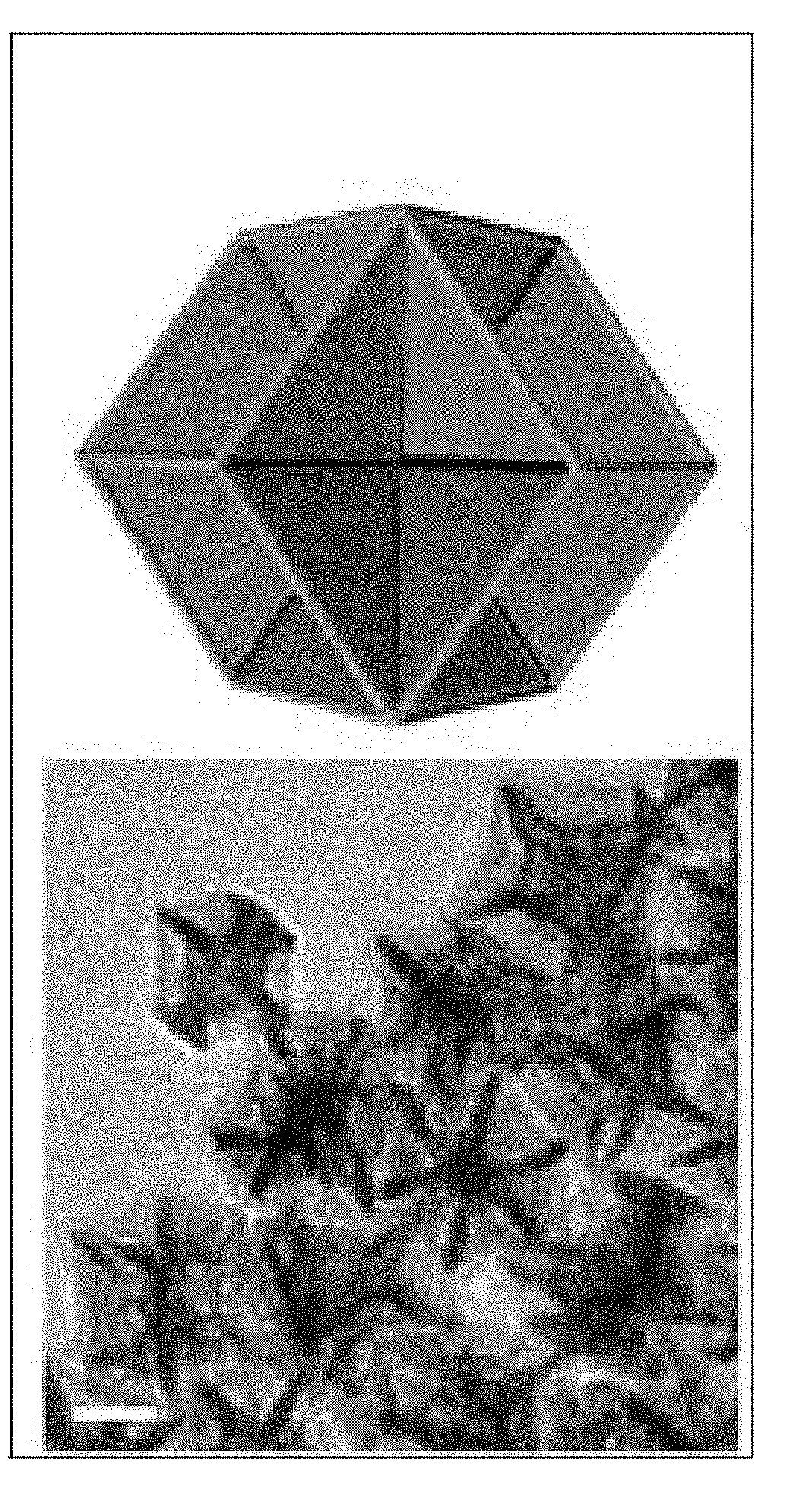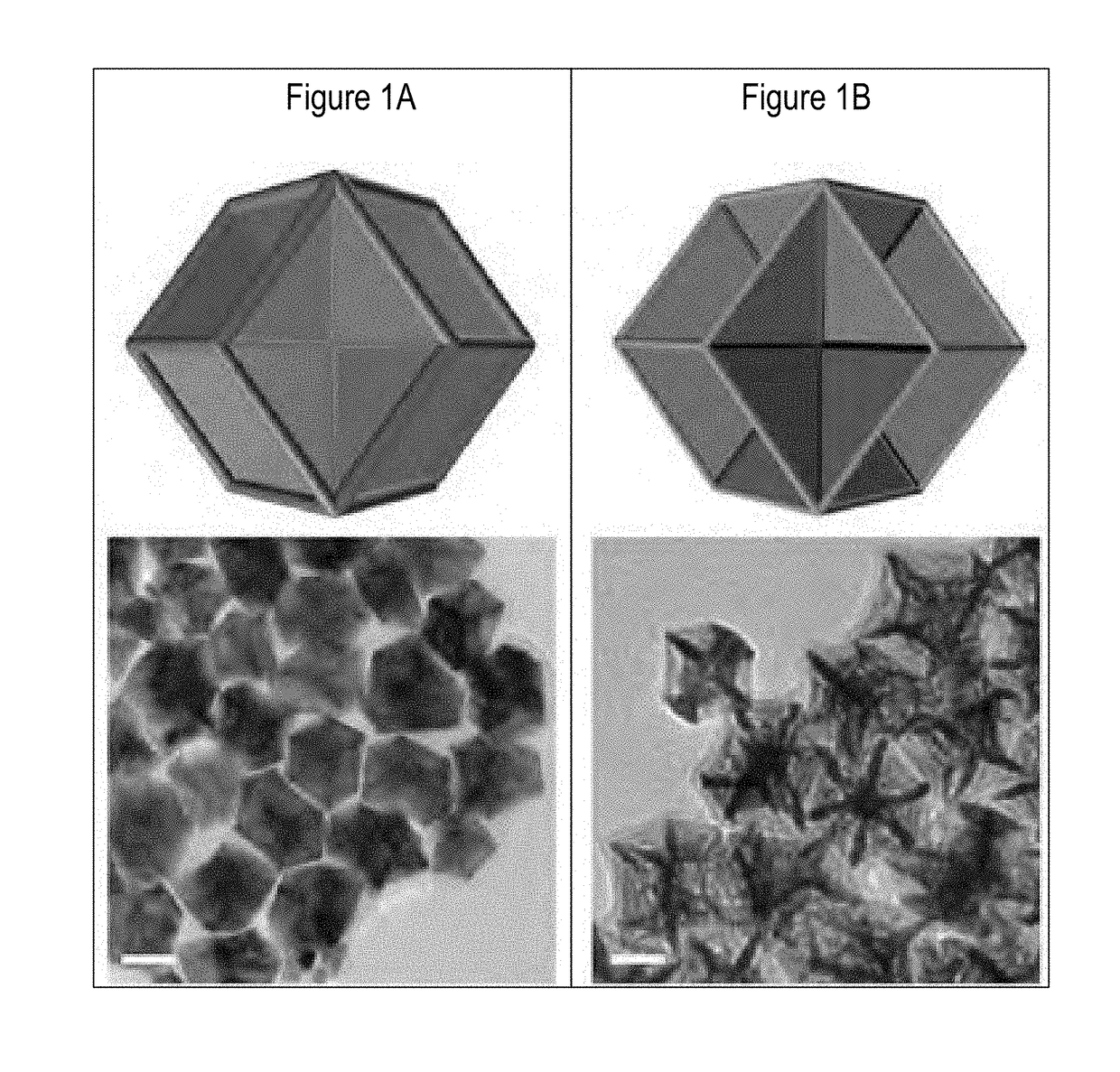Excavated Nanoframes with Three-Dimensional Electrocatalytic Surfaces
a nano-scale electrocatalytic surface and excavated technology, applied in the field of electrocatalytic materials, can solve the problems of high content of these costly materials, insufficient activity and durability, and lack of the requisite activity and durability to enable large-scale commercialization of these technologies
- Summary
- Abstract
- Description
- Claims
- Application Information
AI Technical Summary
Benefits of technology
Problems solved by technology
Method used
Image
Examples
example 1
of Hollow Nanoparticles and Excavated Nanoparticles
[0074]For hollow nanoparticles (H-SD), 20 mg H2PtCl6.6H2O and 21.5 mg Ni(NO3)2.6H2O were dissolved in 0.8 mL oleylamine. The solution was injected into 9.2 ml oleylamine which had been kept at 160° C. under Ar for one hour. The reaction was then kept under vacuum for 2.5 minutes. Then, the reaction was heated to 265° C. with a ramping rate of 15° C. / minute under Ar atmosphere. The color of the reaction solution changed to black after reaching 265° C. The reaction was stopped 5 minute after the color turned to black. The reaction flask was transferred into a water bath in order to quench the growth process. The produced H-SD was washed twice with ethanol and hexane. For excavated nanoparticles (E-SD), the procedures were kept the same except that 20 mg H2PtCl6.6H2O and 11.5 mg Ni(NO3)2.6H2O were dissolved in 0.6 ml oleylamine and injected into 9.4 ml oleylamine.
example 2
of Nanoparticles to Form Nanoframes
[0075]For hollow nanoframes (H-NF), the H-SD were dispersed in 4 ml toluene and mixed with 4 ml acetic acid and 0.2 ml oleylamine, followed by heating at 90° C. in oil bath for 2 hours with reflux system. The collected sample was washed twice with ethanol and hexane.
[0076]For the excavated nanoframes (E-NF), the E-SD were dispersed in 4 ml toluene and mixed with 4 ml acetic acid and 0.2 ml oleylamine, followed by heating at 90° C. in an oil bath for 2 hours with reflux system. The collected sample was washed twice with ethanol and hexane.
example 3
fraction Patterns of Nanoframes and Nanoparticles
[0077]FIG. 5A shows powder X-ray diffraction (XRD) patterns of Pt—Ni hollow nanoframes (H-NF), Pt—Ni excavated nanoframes (E-NF), and the corresponding Pt—Ni nanoparticles (H-SD, E-SD) samples. All samples showed a face-centered cubic crystalline structure with diffraction peak positioning dependent on the composition of Pt and Ni. FIG. 5B shows the magnified and overlapped peak width of the (111) oriented peak for hollow nanoframes and excavated nanoframes. FIGS. 5C and 5D indicate the asymmetry of the (111) oriented peak in the XRD patterns of H-SD and E-SD. The (111) peak in the XRD pattern of H-SD exhibited more drastic asymmetry, which demonstrated obvious phase separation via Pt segregation. E-SD also revealed phase separation, though with less asymmetry. Additionally, the peak position of E-SD was at lower 20 value than H-SD and the intensity to the left of the peak, as marked by arrows in FIGS. 5C and 5D, is much larger in E-S...
PUM
| Property | Measurement | Unit |
|---|---|---|
| time duration | aaaaa | aaaaa |
| time duration | aaaaa | aaaaa |
| temperature | aaaaa | aaaaa |
Abstract
Description
Claims
Application Information
 Login to View More
Login to View More - R&D
- Intellectual Property
- Life Sciences
- Materials
- Tech Scout
- Unparalleled Data Quality
- Higher Quality Content
- 60% Fewer Hallucinations
Browse by: Latest US Patents, China's latest patents, Technical Efficacy Thesaurus, Application Domain, Technology Topic, Popular Technical Reports.
© 2025 PatSnap. All rights reserved.Legal|Privacy policy|Modern Slavery Act Transparency Statement|Sitemap|About US| Contact US: help@patsnap.com



